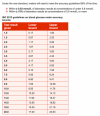About a year ago, after being pre-diabetic for 3 or 4 years, my HbA1c crept up and I became fully diabetic. Since then I’ve been prescribed various tablets. Ordinary Metformin to start with and then slow acting Metformin but I didn't get on with either and I was prescribed Canagofloxin 100mg in February and 300mg a month later.
In February my HbA1c was 61 and it is now 63 and my doctor has stopped the Canagofloxin on the grounds that it is not working and today put me on to weekly self injectable Trulicity 0.75mg.
Over the last few months I have become nauseous, sometimes dizzy, tired and thirsty which I assume is because my blood sugar level is not under control. Are there members out there who have had a similar experience and does Trulicity work?
In February my HbA1c was 61 and it is now 63 and my doctor has stopped the Canagofloxin on the grounds that it is not working and today put me on to weekly self injectable Trulicity 0.75mg.
Over the last few months I have become nauseous, sometimes dizzy, tired and thirsty which I assume is because my blood sugar level is not under control. Are there members out there who have had a similar experience and does Trulicity work?
Last edited:

